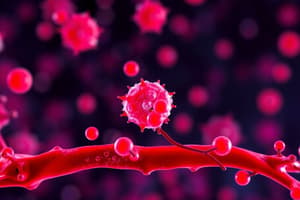Podcast
Questions and Answers
What type of cells primarily occupy the marrow space in severe aplasia as shown in a biopsy?
What type of cells primarily occupy the marrow space in severe aplasia as shown in a biopsy?
- Stromal cells
- Hematopoietic cells
- Lymphocytes
- Fat cells (correct)
What is the most effective treatment option for younger patients with severe aplastic anemia who have a compatible sibling donor?
What is the most effective treatment option for younger patients with severe aplastic anemia who have a compatible sibling donor?
- Iron chelation therapy
- Immunosuppressive therapy
- Supportive care with transfusions
- Hematopoietic stem cell transplantation (correct)
Which of the following treatments is combined with antithymocyte globulin (ATG) for immunosuppression?
Which of the following treatments is combined with antithymocyte globulin (ATG) for immunosuppression?
- Cyclosporine (correct)
- Prednisone
- Methotrexate
- Azathioprine
What is the recommended transfusion trigger level for red blood cells in a patient without functioning bone marrow?
What is the recommended transfusion trigger level for red blood cells in a patient without functioning bone marrow?
Which parameter is NOT used to define severe disease in severe aplastic anemia?
Which parameter is NOT used to define severe disease in severe aplastic anemia?
What best describes aplastic anemia?
What best describes aplastic anemia?
Which of the following is NOT a common cause of acquired aplastic anemia?
Which of the following is NOT a common cause of acquired aplastic anemia?
Which symptom is most frequently observed in patients with aplastic anemia?
Which symptom is most frequently observed in patients with aplastic anemia?
What laboratory finding is characteristic of aplastic anemia?
What laboratory finding is characteristic of aplastic anemia?
Which population is most likely to be affected by aplastic anemia?
Which population is most likely to be affected by aplastic anemia?
What is a typical finding in the bone marrow of a patient with aplastic anemia?
What is a typical finding in the bone marrow of a patient with aplastic anemia?
Which of the following conditions is considered an inherited cause of aplastic anemia?
Which of the following conditions is considered an inherited cause of aplastic anemia?
Which clinical feature is least likely to be associated with aplastic anemia?
Which clinical feature is least likely to be associated with aplastic anemia?
Flashcards are hidden until you start studying
Study Notes
Aplastic Anemia
- Aplastic anemia is a rare and serious condition where the bone marrow does not produce enough blood cells.
- This can lead to anemia, bleeding, and infections.
- Aplastic anemia can be acquired or inherited.
- Acquired aplastic anemia can be caused by radiation, drugs, chemicals, viruses, immune diseases, and pregnancy.
- Inherited aplastic anemia is more common and usually occurs due to a genetic defect.
- The age distribution of aplastic anemia is biphasic, with the peak occurring during teenage years and then again in older adults.
- Men and women are equally affected.
- The prognosis for aplastic anemia is poor, but newer treatments offer some hope.
Causes
- Acquired aplastic anemia can be caused by various factors including:
- Radiation: exposure to high levels of radiation damages the bone marrow cells.
- Drugs and chemicals: some medications and toxins can suppress bone marrow function.
- Benzene: a known bone marrow toxin.
- Allopurinol, leflunomide, gold: several medications used to treat various conditions.
- Viruses: certain viruses can cause aplastic anemia.
- Epstein-Barr virus (EBV): responsible for mononucleosis.
- Hepatitis: non-A, non-B, non-C hepatitis viruses.
- Parvovirus B19: causes fifth disease.
- HIV-1: the virus that causes AIDS.
- Immune diseases: autoimmune disorders can target the bone marrow cells.
- Eosinophilic fasciitis: inflammation of the fascia, affecting the subcutaneous tissue.
- Large granular lymphocytosis (LGL): a type of leukemia.
- Thymoma/thymic carcinoma: tumors in the thymus gland.
- Graft-versus-host disease (GvHD): complication of bone marrow transplantation.
- Paroxysmal nocturnal hemoglobinuria (PNH): a rare blood disorder that affects red blood cells.
- Pregnancy: hormone changes during pregnancy may contribute to aplastic anemia in some women.
Symptoms
- Symptoms of aplastic anemia include bleeding, weakness, fatigue, and shortness of breath.
- Early symptoms often include:
- Bleeding: easy bruising, oozing from gums, nosebleeds, heavy menstrual flow, petechiae.
- Anemia: lassitude, weakness, shortness of breath, and a pounding sensation in the ears.
Diagnosis
- Diagnosis is made based on blood tests, bone marrow biopsy, and medical history.
- Blood Tests:
- Low red blood cell count (anemia),
- Low white blood cell count (neutropenia),
- Low platelet count (thrombocytopenia).
- Large erythrocytes and absence of platelets and granulocytes.
- Mean corpuscular volume (MCV) tends to be increased.
- Low or absent reticulocytes.
- Bone Marrow Biopsy: the bone marrow shows a low number of blood forming stem cells.
Treatment
- Treatment of aplastic anemia depends on the severity of the disease.
- The most effective treatment is hematopoietic stem cell transplantation.
- Hematopoietic Stem Cell Transplantation (HSCT): This involves transplanting healthy stem cells from a donor into the patient's bone marrow. It is the best option for patients with a fully histocompatible sibling donor. Long-term survival rates for children with this treatment can be as high as 90%.
- Immunosuppression: This involves using drugs to suppress the immune system and allow the bone marrow to recover. Immunosuppressive therapy is a suitable option for patients without a matching donor, with 60-70% of patients experiencing hematologic recovery. However, relapse is common.
- Antithymocyte Globulin (ATG): A combination of ATG and cyclosporine is commonly used.
- ATG Administration: Horse ATG administered through intravenous infusions over 4 days.
- Methylprednisolone: Administered alongside ATG to alleviate immune complications.
- Cyclosporine: Administered orally at a high initial dose that is later adjusted based on blood levels every 2 weeks.
Supportive Care
- This includes transfusions and antibiotics to manage the effects of low blood cell counts.
- Transfusions:
- Red Blood Cell Transfusions: To maintain normal activity and a hemoglobin level of 7 g/dL.
- Platelet Transfusions: To control bleeding.
- Antibiotics: To treat infections, which are a significant risk due to neutropenia.
Prognosis
-
The prognosis for aplastic anemia depends on the severity of the disease and the response to treatment.
-
Prognostic Factors:
- Blood count: Severity of the anemia, neutropenia, and thrombocytopenia.
- Age: Younger patients often have a better prognosis.
- Response to treatment: Patients who respond well to treatment have a better prognosis.
- Underlying cause: Some causes of aplastic anemia have a better prognosis than others.
-
Patients with severe aplastic anemia have a poor natural history with a high likelihood of rapid deterioration and death.
-
However, newer treatments, such as hematopoietic stem cell transplantation and immunosuppressive therapy, offer some hope for recovery.
Studying That Suits You
Use AI to generate personalized quizzes and flashcards to suit your learning preferences.




